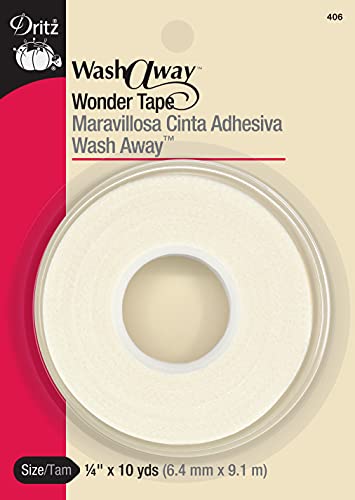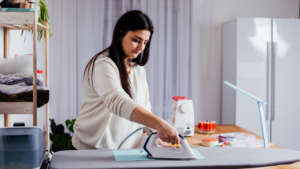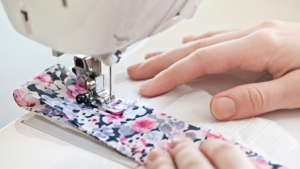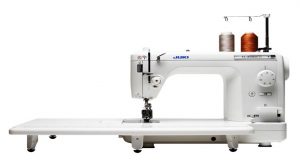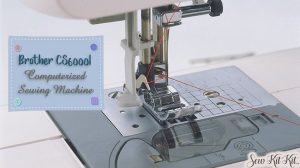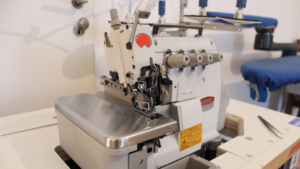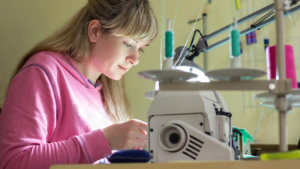Last Updated on January 10, 2023
Whether you are a beginner sewer or a pro, having the right tools is a must. In today’s article we are going to share our picks for the best sewing tools.
When you buy through links on our site, we may earn an affiliate commission. As an Amazon Associate I earn from qualifying purchases.
In any good tailor’s workshop, the sewing machine does most of the job. But this does not mean that you should give the least importance to the sewing tools and trinkets involved in sewing. These simple things also contribute to making your sewing experience efficient and enjoyable.
Sewing is an expensive hobby. Sure, you can start with a cheap second-hand machine and a basket of basic supplies. But later on, you start getting more and more into the hobby, which often happens naturally, so don’t fight it.
Having just the right tool for your projects feels just as important as sending your kid to the right school. Much like numerous craft-related hobbies, sewing involves a lot of equipment.
The longer you take up the hobby, the more you find yourself investing in tools and accessories to enhance your experience while raising your work’s quality. When learning how to sew, it may be daunting to see all the different tools available to you when working on projects.
The options are truly diverse, but you can also simply work with the essential tools, and this list gives you the perfect guide to get you started. Feel free to pick and choose what you need to build your very own sewing kit.
1. Janome HD3000 Heavy-Duty Sewing Machine
The Janome HD3000 Heavy-Duty Sewing Machine is our choice for best sewing machine.
- Built-in needle threader
- Reverse stitch lever
- Snap-on presser feet
- Foot pressure adjustment
- 18 stitches, 1 one step buttonhole
This sewing machine is our primary choice for working with heavy fabrics for beginners that feature stitch adjustability. If you’re aiming for convenience while working with thick and heavy fabrics, the Janome HD3000 is the way to go.
This model is a heavy-duty sewing machine with a metal frame that provides excellent stability and strength required when tackling thick fabrics. This model also comes with various sewing accessories that will be useful for beginners and tools like a 4-presser feet screwdriver, handloom, power cord, a book for embroidery, and a manual.
This sewing machine also features a high presser foot that allows you to hold multiple layers of thicker and heavier fabrics easily. It is particularly recommended for beginners since its various features and design make working with weightier fabrics easier and more convenient. Apart from its sturdy frame, the model has a few built-in stitches, a needle threader, an automatic bobbin winder, a five-piece feed dog with more advanced features and functions.
Janome features an extension table that lets users accommodate larger pieces of fabric and allows you a wider space to work in comfortably. This model enables you to freely choose the right stitch length when working on thicker fabric with its built-in stitch adjustability.
This machine is capable of generating around 1,500 stitches per minute, ensuring your efficiency and productivity. Apart from that, this model also has a presser foot that allows a one-foot pedal operation for manual speed control. It is also budget-friendly, all while uncompromising in its quality and experience.
2. Tailor’s Ham
The Tailor’s Ham is our choice for best tailor’s ham.
- Two Sides For Different Temperatures
- Press As You Sew For A Professional Finish
- Press With Grain Line Of The Fabric, Using A Gentle Up And Down Motion
- Model Number:
Contrary to most jokes heard in public, a tailor’s ham isn’t actually made from pork. It is a stuffed tool to help a tailor with pressing. It is no longer a secret that the best way to professional garment sewing is good pressing.
If you’re dealing with a garment that has curves like princess seams or a collar, you’re going to need to be able to press those curves without deforming them on an ironing board. Enter the tailor’s ham. A tailor’s ham has two sides: one made from cotton and is for pressing cotton and other smooth fabrics, the other is often plaid wool which is intended for pressing wool and other similar fabrics with a nap.
There are plenty of different curves in a tailor’s ham, depending on how you tip it. You can use a pointer or rounder end, and you can also use the edge and other curves depending on the fabric you are working on.
The only thing you should do is place the seam to press over the part of the ham. This way, the ham that most corresponds to the curves will be flawless, and you can start pressing.
But, be very careful, as you might have to hold the ham in one hand and press with the other. Be wary not to steam your fingers.
3. Gingher 8-inch Knife Edge Dressmaker’s Shears
The Gingher 8-inch Knife Edge Dressmaker’s Shears are our choice for best edge dressmaker’s shears.
- Longer cut ideal for patterns, seams or long swaths
- Knife edge cuts multiple layers
- Bent handle design holds fabric f
Finely crafted and sharp, Gingher 8-inch Knife Edge Dressmaker’s shears are capable of slicing through almost any fabric with precision and strength. It is known to originate from a country that is primarily famous for its fine tailoring, Italy.
These shears were made from high-carbon cutlery steel, which is hot-drop forged. Then they are double-plated, adding chrome and nickel to the mix. For final touches, it is ground and polished for a beautiful but durable appearance.
The best thing about this sewing tool is that it can hold 4-inch blades that are hand-tuned to perfection and has the durability you need. Commonly described as reliable and traditional, these shears are truly built for heavy-duty work and look conventional with metal handles that most users describe as more comfortable and stronger than plastic handles.
The top of the blade to the tip can cut material and fabric with precision and force. You will be able to carve out pieces according to patterns, maneuver around curves, and trim seams as well. It is also a given that you will be able to cut long, clean lines and large swaths of fabrics with efficiency and ease.
Most tailors out there rate it as “best for most users,” and it can even slice through a double-layered fabric with no issues. As a result, most tailors will save time during their actual sewing.
The bent handle helps hold the fabric flat on a surface for a smooth, efficient, and comfortable cutting experience. An included nylon sheath protects the shears when they’re not in use.
4. Dritz Wonder Tape
The Dritz Wonder Tape is our choice for best wash away tape for sewing.
- Perfect for holding together seams or hems before stitching
- Can be sewn through without gumming up your needle
- Great for home sewing or crafting
- This package contains 1/4: x 10-Yards of Wash Away Wonder Tape
- Tape is for temporary use
- Permanent use could result in yellowing and staining of fab
While sewing, using sticky tape may feel sacrilegious to some or at least view it as a low-quality sewing method. That is until they hear about the splendor of wonder tape.
Dritz Wonder Tape is a water-soluble, thin, double-sided sticky tape that won’t gum up your machine and will wash out as soon as you put your fabric in the laundry. Its primary purpose is similar to that of safety pins but without all the bumps while still providing a consistent hold on your fabric.
Also, it is a lot tidier than glue sticks and hot glue. Using Dritz Wonder Tape, you will be introduced to a lot of wonders when it comes to sewing. Eventually, you will learn more tricks that can only be achievable using this tool.
Here are some top uses of Dritz Wonder Tape:
- Use them to seal black button packets before topstitching. Anywhere you may feel the need to be accurate, wonder tape is there to help you.
- Topstitching a waistband is not easy. Most of the time, you expect to catch the open underside. This is without it flapping around and using Wonder Tape will give you the desired result. It’ll keep everything closed and no hidden pins on the wrong side to wrangle and tussle with.
5. Singer All Purpose Pressing Foot
The Singer All Purpose Pressing Foot is our choice for best presser foot for versatility.
- The All-Purpose Foot is used for general sewing on most types of fabric. The All-Purpose Foot may also be used for elastic insertion and basic mending.
- The foot’s wide needle slot allows for sewing of stitches up to 7mm in width.
- Genuine SINGER Accessory in carded blister pack.
- For use with low-shank sewing machines, including brands Babylock, Bernina, Brother, Elna, Euro-Pro, Husqvarna Viking, Janome, Juki, Kenmore, Necchi, New Home, Pfaff, Simplicity, White.
- Downloadable instructions and video tutorial available on this product page!
- This sewing machine is warranted for use in the US and Canada at 110 volts on
Beginners may find it hard to have a steady hand when they sew for the first time. In this case, an edge-stitching foot or a pressing foot might just be the gadget that helps them achieve the perfect topstitch even as a novice.
Note that these feet only work if your machine can move the needle to the left and right. Otherwise, this foot will not be able to do its intended purpose.
When it comes to edge-stitching, Singer has it all, and the secret lies in its blunted blade, which you can find in the middle of the foot that is present in some blind hem foot. This combination fits perfectly, and they work equally well.
You only need to place the blade into the seam or sometimes at the edge of each fabric. Then you can push the needle to either left or right, depending on where you want to do the topstitch.
The blade’s purpose is to “stick” to the seam and guide the needle accurately, producing excellent results. This gadget is the type of tool RTWs are made with and also massively lowers the skill level needed while still giving professional results.
Questions and Answers
What Are The Common Sewing Tools You Need?
Anyone will find it challenging to find the right tools, even for professionals or beginners in sewing. You should ensure that you have the basic sewing tools if you are sewing for the first time as these tools can help you achieve great results and let you avoid accidents while sewing.
If you have the following sewing tools, you can get started with your sewing career. Most of these are also known to help you to take on some easy and friendly sewing classes.
- Pins and Pincushion
- Hand Sewing Needles
- Sewing Needle Threader
- Seam ripper
- Iron and ironing board
- Sewing Scissors
- Pinking Shears
- Sewing Tape Measures
- Bodkin
- Fabric Rotary Cutter
Having all of these tools ready with you will allow you to have a better sewing experience. As a beginner, remember that less is more.
You only need to pick the essential tools you need to start your work and your soon-to-be collection. If you need help with these sewing tools, don’t hesitate to ask a sewing teacher.
What Are The 3 Most Important Tools For Sewing?
If you’re a beginner in sewing, chances are you may be a bit confused and unfamiliar with the different tools people use when they’re engaged in the hobby. While tons of different tools are available to every sewing enthusiast, these three tools are certainly the most essential. Whether you’re a novice or a master tailor, you will mostly need:
1. Pincushions Full of Pins
A pincushion is simply a receptacle where you can stick your pins and needles while working on a project. For the most part, a lot of pincushion designs are shaped like a tomato. Some people have strawberries dangling from the top but any size and shape are welcome when it comes to pincushions.
2. Sewing Shears
Designed ergonomically to prevent and avoid hand fatigue, sewing shears ensure that you cut your fabric with accuracy and strength. However, though they are basically scissors, you must remember to use them on fabric only because using them with any other material will dull the blades. It may not seem to be an issue at first, but using it constantly the wrong way can cause uneven cutting and shredding once they are used again on fabric.
3. Tape Measures
You will likely need a tape measure, or several tape measures at that to sew properly. The retractable type of tape measure also comes in handy in a pinch, so you might want to consider investing in one.
You can also use the standard tape measure with metric units on one side, such as centimeters and millimeters, and American units on the other side, which are the inches, feet, and yards. They can be used to take body measurements, but they are commonly used for more everyday tasks like measuring fabric in accordance with patterns.
How Many Scissors Do You Need For Sewing Fabrics?
Basically, you should aim to have a pair of each of the following in your sewing tool kit. Save up and buy quality so that you will only need to buy them once.
- Fabric shears (at least 8 inches / 20cm) – These shears have handles set at an angle to ensure that the fabric is lifted as little as possible from the cutting surface. The handles of this pair tend to be made larger to accommodate your fingers, and the handles are made to be a comfortable fit. These shears come in different sizes, which refers to the length of the blades. 8” shears are the go-to size for a novice dressmaker.
- Small scissors or snips – These are a useful substitute for snips. Make sure to choose a pair with large bows or handles for comfort and ensure that they have sharp points. These scissors are for snipping threads when working on your sewing machine or for unpicking and removing tacking.
- Paper scissors (a cheap pair of fabric shears are best)
- Appliqué scissors – These are yet another pair of unusually shaped scissors. Also known as duck-billed or napping scissors, these are mostly used for layering seams. The wide blade at the bottom allows you to layer seams together with no danger of accidentally cutting through the fabric underneath. These scissors are also used to cut in reverse applique.
- Buttonhole scissors – Another unusually shaped scissor with short blades often comes with an adjustable screw between the handles. The screw is adjusted so that the scissors can only cut in the length of your buttonhole. Using this is so much tidier than making buttonholes with a seam ripper.




